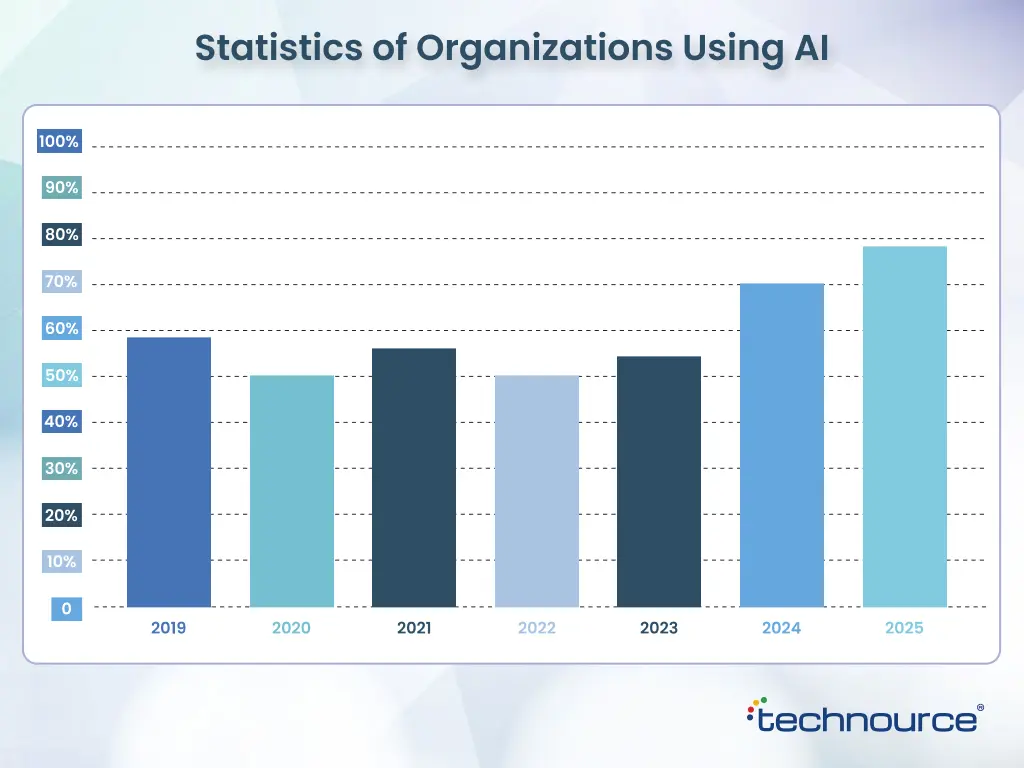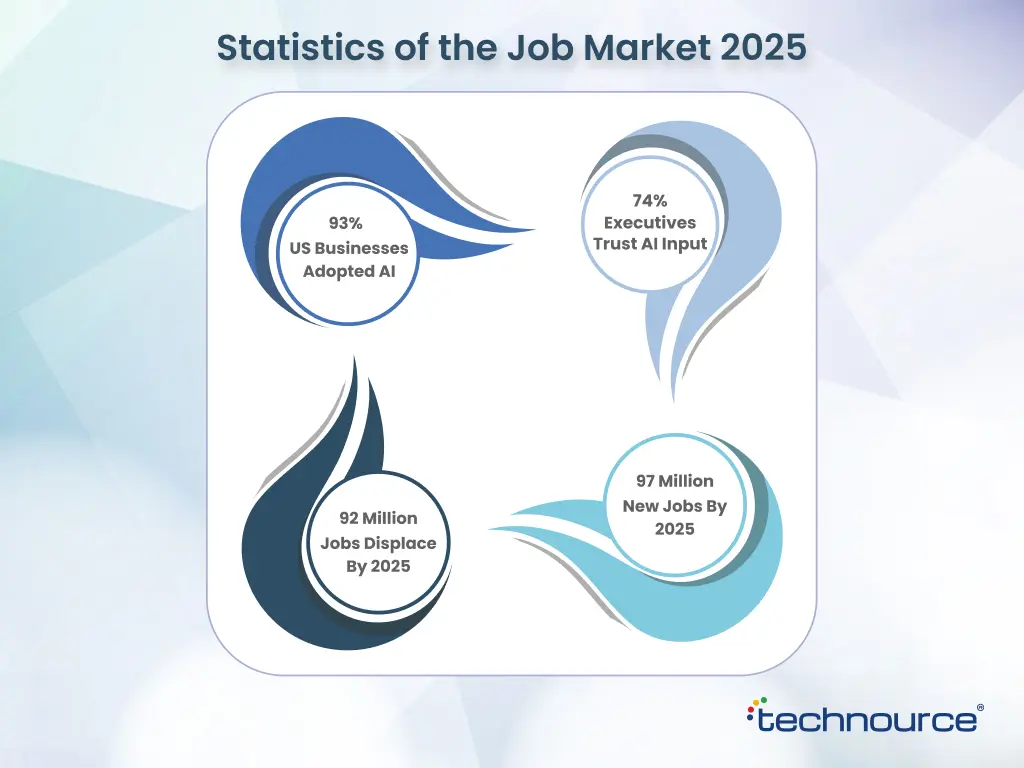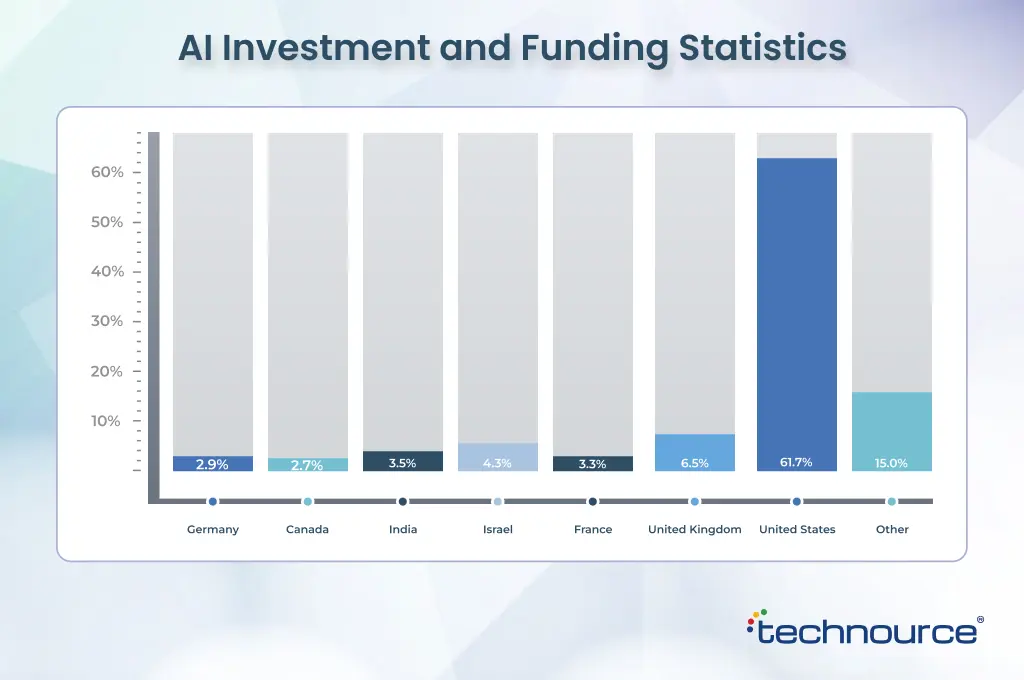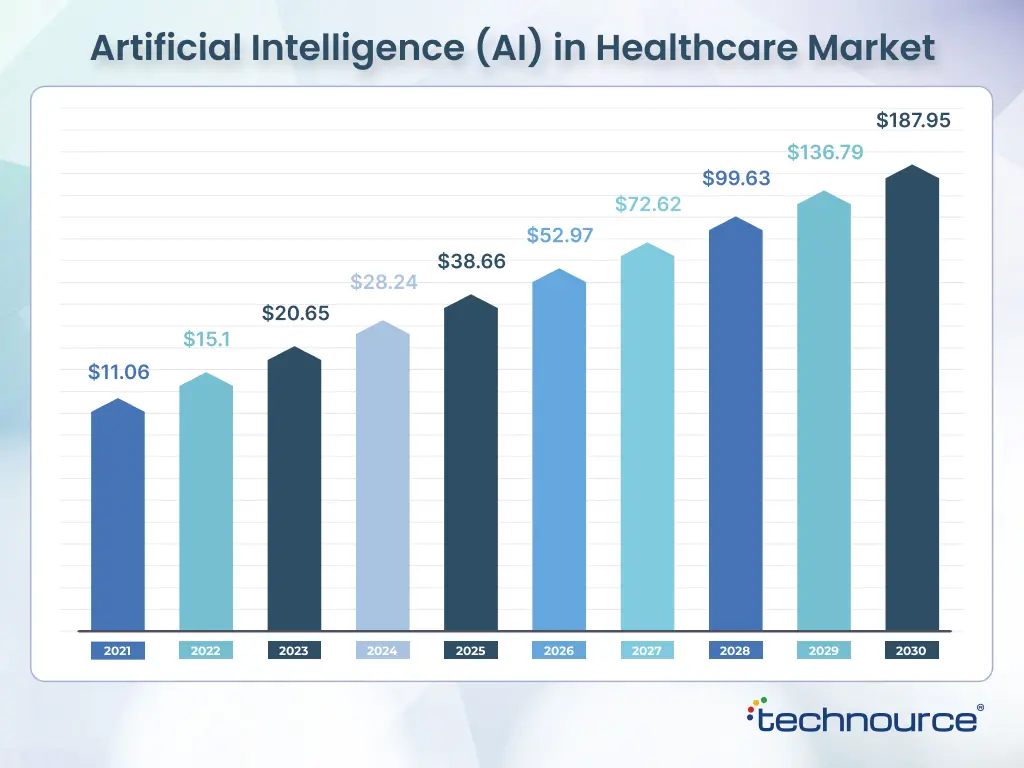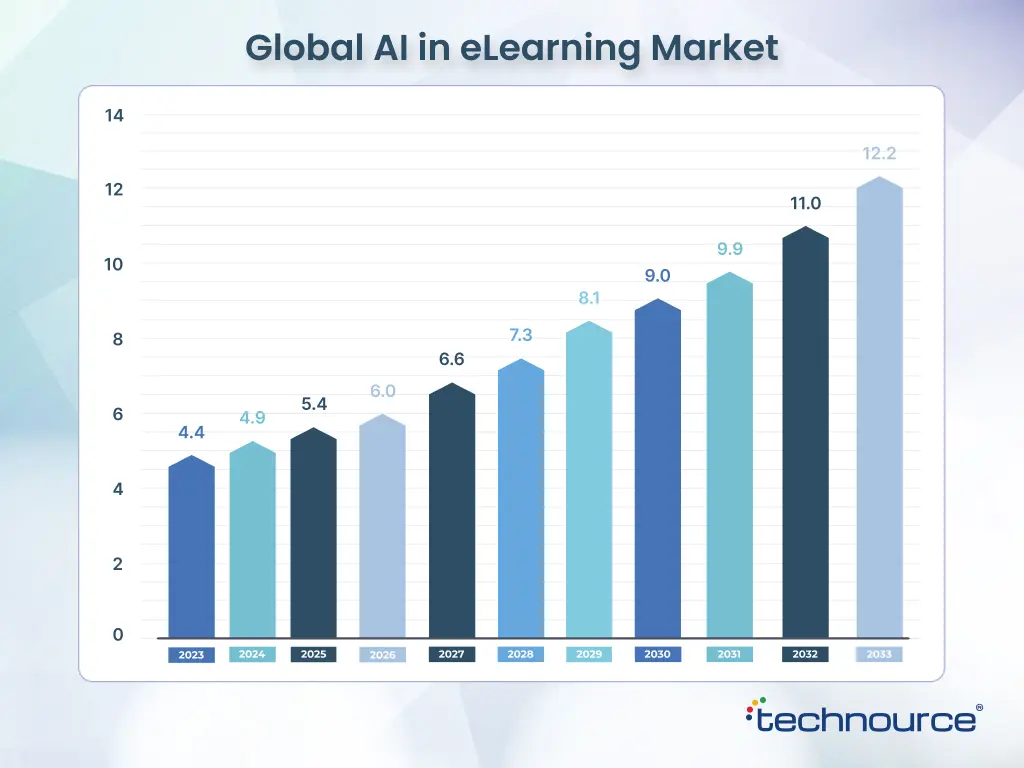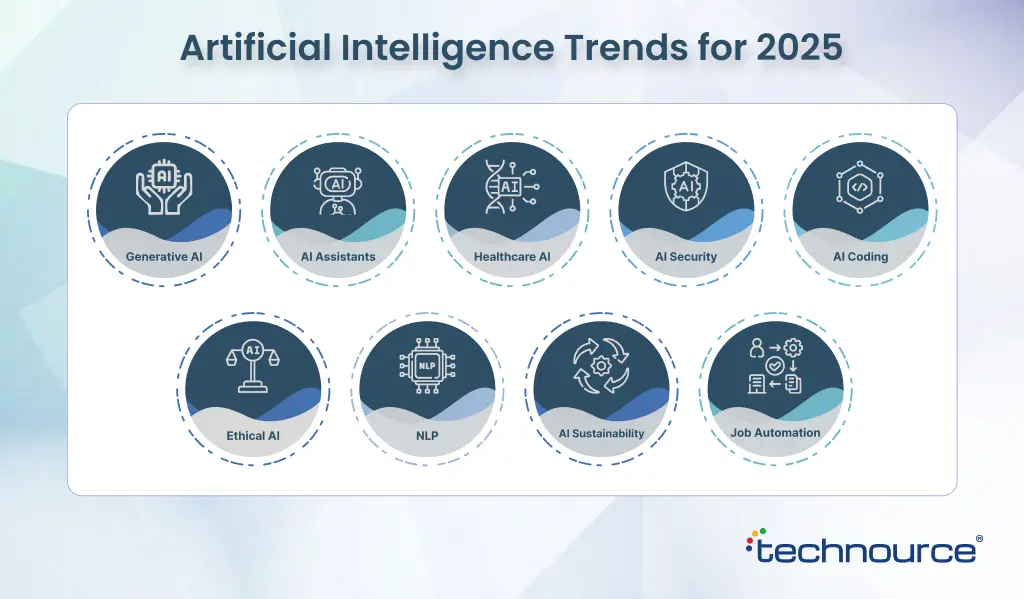Artificial Intelligence(AI) Statistics and Trends 2025: Data, Insights, and Growth
Quick Summary: Artificial Intelligence is not only here, it’s reshaping industries. This blog walks you through over 100 essential AI statistics and key AI trends for 2025 in such areas as market size, adoption rates, funding shifts, workforce impacts, and emerging technologies You’ll experience real-case examples, definitive sources of information, and a keen-eyed snapshot of how business is evolving with AI today.
My initial experience with AI involved a humble chatbot program barely adept at matching customer demands, but today’s AI drives enterprise dashboards, predictive diagnostics, and autonomous vehicles in industries.
As per Grand View Research , today’s global AI marketplace is set to rise from $279 billion in 2024 to an unprecedented figure of $390.9 billion in 2025 at an estimated CAGR of 35.9% over 2030.
For leaders, these numbers aren’t just forecasts—they’re signals to build readiness, capability, and strategy around AI. Let’s explore what the data reveals.
The Current State of Artificial Intelligence
Artificial intelligence is no longer an option, it’s a presence. From the apps we check every morning to the systems running global supply chains, artificial intelligence has quietly become the invisible engine of modern life. Whether it’s predictive text, fraud detection in banking, or medical imaging that speeds up diagnosis, AI touches both consumers and enterprises daily. The reality is, companies that delay adoption risk falling behind competitors already using AI as a growth lever.
72% of companies are now adopting AI, versus about 50% six years ago. 78% of companies are forecast to adopt at least one business function involving AI by 2025.
Key Artificial Intelligence (AI) Statistics You Should Know
While conversations around AI often highlight futuristic possibilities, the present reality is just as compelling. Businesses are no longer asking if they should adopt AI but how fast and where.
From startups to Fortune 500s, organizations are embedding AI into customer experience, supply chains, and internal workflows.
Understanding the current adoption levels and usage patterns helps us see how deeply artificial intelligence has penetrated everyday operations.
- As of 2025, 78% of organizations use AI in at least one business function,This reflects a significant increase in adoption from previous years.
- Around 83% of companies rank AI as a top strategic priority.
- SMEs in the UK now adopt AI daily in nearly a third of businesses, with 84% reporting success.
- Nearly half of Fortune 1000 companies are fully integrating AI in their workflows.
- SMEs in the UK—about a third use AI daily, and 84% of users report positive results.
Global AI Market & AI Growth Statistics
- AI spending by tech giants (Amazon, Google, Meta, Microsoft) is expected to reach $402 billion by 2026.
- AI could generate $275 billion in annual cost savings and $780 billion in revenue by 2030.
- The US led global private AI investment in 2024 with $109.1 billion, nearly 12× China and 24× the UK.
- Generative AI alone drew $33.9 billion in private investment in 2024—an 18.7% year-on-year rise.
AI Revenue and Spending Statistics
- AI spending is forecast to be $110 billion in 2025.
- Over 30% of enterprise IT budgets are now earmarked for AI and automation.
- CFOs report 44% lack internal AI automation skills, despite AI’s growing business use.
- One in four desk-based employees experimented with AI tools by early 2024.
- Two out of five companies globally use AI, with India leading at ~59% adoption.
Business & Enterprise AI Adoption
- 57% of finance teams actively use AI for operations; another 21% have AI tools but haven’t deployed them yet.
- 65% of businesses cited reducing manual tasks as their primary reason for adopting AI.
- Netflix earns $1B annually from AI-driven recommendations.
- 48% of businesses use AI for big data processing.
- 38% of medical providers use computers (AI) to assist in diagnosis.
- In the U.S., email spam filters are used by 78.5% of workers—the most common AI application.
- 62.2% of industries use chatbots for customer service.
- 61.4% use virtual assistants personally; for workers, it’s 28.9%.
- In finance, 81.1% of workers rely on spam filters daily.
- Real estate employees use wearable fitness AI at 43.8%, vs 30.2% in warehousing.
- 65% of high performers use AI in IT compared to 28% of other companies.
- 83% of CFOs say that AI helps streamline workflow due to workload limits.
- 89% of finance teams still use Excel despite AI adoption.
- CFOs investing >=5% in AI report higher returns.
- 47% of business owners believe ChatGPT will boost credibility.
- 97% of business owners think ChatGPT will benefit operations.
Workforce and Job Market AI Statistics
The rise of AI is redefining the future of work. Some roles are at risk, while others are being created at a pace we’ve never seen before. Let’s check the statistics of the job market.
- The World Economic Forum (WEF) predicted in its 2020 report that AI-related technologies would create 97 million new jobs by 2025
- The US added 109.1 billion USD in private sector AI investments.
- AI adoption may displace 92 million jobs by 2025 , raising concerns about workforce reskilling, job security, and economic inequality across industries.
- Only 2% of companies meet responsible AI standards, despite 95% facing an AI mishap.
- 93% of US businesses have adopted AI, but only 50% of employees have received training.
- Over 220,000 employees at JPMorgan now use internal LLM tools for data summarization.
- PwC trained 90% of staff in prompt design and responsible AI via their AI Academy.
- 74% of executives trust AI input more than their colleagues; 44% let AI override their judgment.
- LinkedIn found AI proficiency is becoming expected job competency— 1/3 of execs plan to include it in performance reviews.
- 95% of organizations studied get zero return on their AI investment.
- By 2030, AI could automate 30% of work hours globally.
- AI-related jobs are growing at a rate of 74% annually on LinkedIn.
- AI engineer salaries in the U.S. average $164,000 annually.
- 60% of employees say AI reduced time spent on repetitive tasks.
- 40% of companies plan to reskill employees for AI tools by 2025.
- AI demand in cybersecurity has grown 4× in 5 years, creating thousands of new analyst jobs.
AI Investment and Funding Statistics
The surge in AI adoption wouldn’t be possible without massive investments. From startups to tech giants, here are the key AI Investment and Funding Statistics for 2025
- EU launched InvestAI with €200 billion investment for AI infrastructure.
- French investors pledged €110 billion for AI projects.
- Brazil: only 16.9% of large companies used AI in 2022, mostly in admin (73.8%) and product development (65.9%).
- India’s AI market will hit $8 billion by 2025, growing at 40% CAGR.
- China invested ~$100B in AI and robotics in 2025.
- The UK AI market was £21 billion in 2025 , expected to exceed £1 trillion by 2035.
- Global corporate AI spending is projected at $300 billion in 2026.
- Venture funding in AI startups hit $67 billion in 2023.
- Healthcare AI startups attracted nearly $9.3 billion in 2024.
- AI fintech startups received over $12 billion in funding in 2024.
- China accounted for 25% of global AI venture funding in 2024.
- The AI semiconductor market is expected to exceed $100 billion by 2030.
AI Technology-Specific Statistics
- ChatGPT reached 1 million users in just 5 days.
- OpenAI.com sees 1.2 billion visits monthly as of mid-2025; ChatGPT.com racks up 5 billion.
- AI software revenues are projected at $126 billion in 2025.
- Wearable AI market is forecast to reach $180 billion in 2025.
Industry-Specific AI Adoption Statistics
From manufacturing floors to marketing teams, AI is transforming how industries work at every level. The following statistics will show AI adoption statistics in different Industries
- AI in healthcare: projected $188 billion by 2030 in AI healthcare tools.
- AI in finance: 57% of finance teams use it actively.
- AI in Travel industry: hotels use AI kiosks to reduce check-in times and staff costs.
- AI in Real estate: It reduces valuation errors by up to 20%.
- Manufacturing in Germany: AI adoption rose from 6% in 2020 to 13.3% in 2023.
- Generative AI patents: China filed 38,000+ patents from 2014–2023, surpassing the U.S.
- In education, AI edtech investments reached $6 billion in 2024, with rapid adoption in tutoring tools.
- Asia-Pacific: 68% believe AI positively impacts the world, vs 57% globally.
- Retail AI spending is expected to exceed $24 billion in 2025, driven by personalization engines.
- 70% of online shoppers say AI-powered chatbots improve their purchase experience.
- In healthcare, AI could save the industry $150 billion annually by 2026.
- AI in automotive is projected to hit $15.9 billion by 2027.
- Agriculture AI tools are projected to reach $4.7 billion by 2025, driven by smart irrigation and drones.
Top Artificial Intelligence Trends for 2025
AI is evolving faster than ever, and 2025 is set to bring game-changing innovations. From generative AI to ethical frameworks, these trends will significantly shape how businesses and individuals utilize AI in the years to come.
- Generative AI adoption in enterprises has doubled year-over-year since 2023.
- Responsible AI frameworks are a top priority for 72% of Fortune 500 CEOs.
- By 2025, 70% of customer interactions will use AI tools like chatbots.
- AI agents are forecast to cut software development timelines by 25%.
- AI in edge devices is projected to reach $36.6 billion in 2025.
- AI in cloud computing is set to hit $27 billion by 2025.
- AI in gaming projected to surpass $7.1 billion by 2030.
- Generative AI content creation tools could save marketers 30% of campaign costs.
- AI-driven supply chain optimization could reduce costs by 20% annually.
- AI in cybersecurity will grow to a $133 billion market by 2030.
- AI voice assistant usage expected to surpass 8.4 billion devices globally by 2025.
- The AI boom is valued at $391 billion globally.
- AI industry expected to grow 5× over 5 years.
- Generative AI is used by 71% of organizations.
- Meta, Google, Microsoft, Amazon collectively to spend $402 billion on AI by 2026.
- AI agents generate up to 30% of code for some teams.
- MIT report: 95% of U.S. companies investing in generative AI saw little ROI; only 5% scaled successfully.
- Cultural divide: only 21% of workplaces have AI policies, and few offer training.
- British SMEs: 20% remain cautious but considering AI in future.
- C-suite trust: 74% of execs trust AI more than peers, as we mentioned earlier.
- PwC’s AI academy trained 90% of employees.
- The global AI software market is forecasted to reach $1.09 trillion by 2032.
- Natural Language Processing (NLP) accounts for ~37% of AI applications worldwide in 2024.
- Computer Vision is projected to hit $48.6 billion by 2025.
- The global AI hardware market is forecast to surpass $234 billion by 2030.
- By 2025, AI chips will be embedded in 75% of smartphones shipped globally.
Conclusion
These AI statistics and AI market trends aren’t just numbers—they’re the story of an industry in motion. Businesses that lean on insights like rising adoption, ethical pressure, and AI funding will not just adapt—they’ll lead. At Technource, we’re applying these insights to help our clients build AI tools that are not only powerful but purposeful—whether through chatbot development or AI-powered software development solutions.
Request Free Consultation
Amplify your business and take advantage of our expertise & experience to shape the future of your business.



